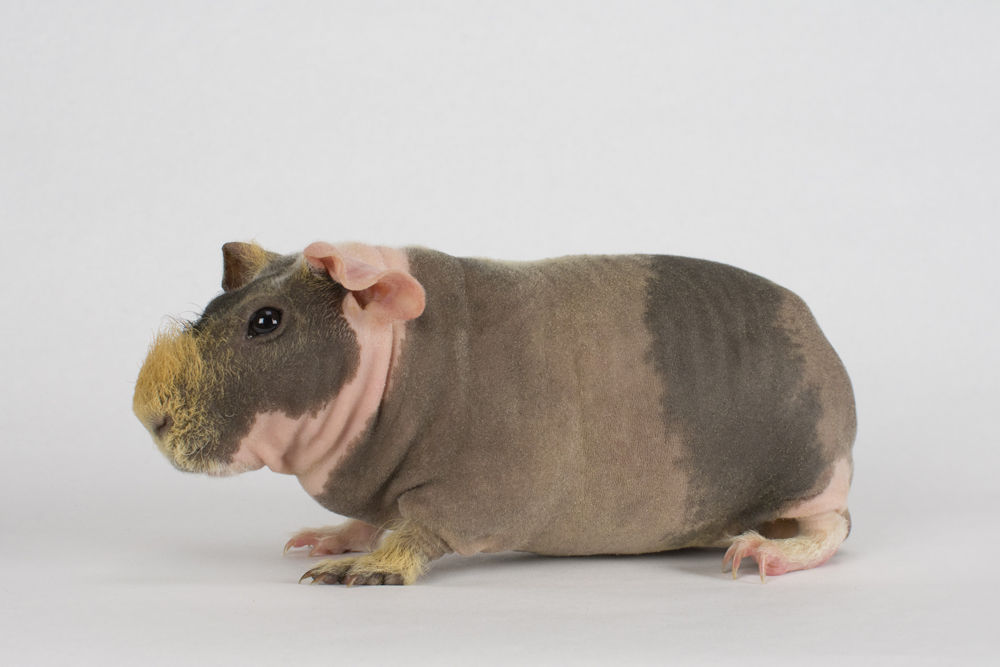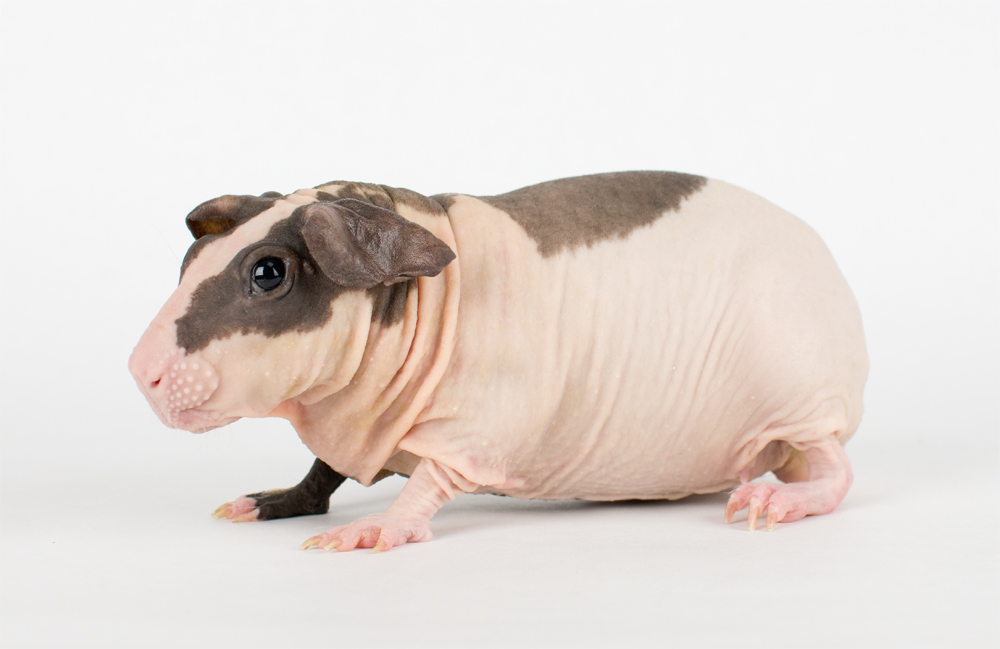Baldwins vs Skinny Pigs
I am often asked, "What is the difference between Baldwin guinea pigs and skinny pigs? The short answer is that they are two different types of hairless guinea pigs. Each breed is the result of a specific genetic mutation that doesn't express unless two copies of the gene are present (double recessive). They are so distinct and unrelated that if you breed a skinny pig to a Baldwin guinea pig, all the babies will be furry and none will be hairless. You can read my article, "Considerations on Breeding," for additional information. But beyond that, I personally think of Baldwin guinea pigs as "hard mode" for guinea pig owners.
Okay so here's how I look at it. And this isn't scientific or anything, just my gut feeling. Skinny pigs have skin kind of like ours. It's soft in texture and relatively sturdy. It does scratch easily and is prone to some other conditions such as ring worm, but overall is pretty protective. I think of their skin as being skin that is prepared to not have much hair on it.

skinny pig
Baldwin guinea pigs, on the other hand, have skin that is more of a tacky, rubbery texture and it seems to me to be very thin. More like the skin of a very old person. It is very sensitive, scratches easily and sometimes may even bleed a little just from routine scratching or excessive grooming (usually happens on the neck, where lots of wrinkles are). Their skin seems more sensitive to build up of dead skin cells, about the same sensitivity to ringworm, and possibly higher sensitivity to bacterial skin infections. I think of their skin as being skin that is prepared to have fur on it and protecting it, but doesn't have that fur. So without it, it's a lot more vulnerable. Their skin is also well know for developing very small pimples as they grow older. These are naturally very small and do not need any additional care or treatment. Baldwin guinea pigs also seem to frequently produce more eye-cleaning substance (the white goo that is formed in the corners of the guinea pig's eye) and their nails often grow much more quickly than other guinea pigs. I have not noticed any increase in speed of teeth growing (thankfully!). One person I was talking to theorized maybe all these things are related to their thyroid, since the thyroid can affect skin, hair, and nails. Perhaps the cause of their loss of hair as babies (since they are born fully-furred) is also related to the faster nail growth and increased eye stuff. Baldwins seem to me to be, on average, large in body than skinny pigs. They tend to be stocky critters. They generally have larger, droopier ears than skinny pigs do.

Baldwin guinea pig
I usually do not bathe my skinny pigs nor do I recommend it unless they get dirty or have an excessive buildup of dead skin cells on them. But Baldwins I recommend more frequent bathing, possibly as often as once every 2-3 weeks. Their nails should be checked weekly and trimmed as needed. It may be impossible to keep their nails looking perfect as they sometimes grow in somewhat off-center directions. I wonder if their nails are any softer than with other piggies? And thus the weight of the guinea pig presses the nails flatter and forces them to grow to the side instead of straight. They do often seem flatter now that I think about it. Regular guinea pig nails tend to have a nice curve to them. Baldwins, not so much. Something that is good to do for owning any pet, but that I would especially recommend for owning a Baldwin is finding your nearest animal dermatologist ahead of time. I don't think they need regular visits, but that you should know where one is ahead of time in case you see anything strange going on with their skin. Here is the website I recommend for finding a veterinary dermatologist near you. I was surprised at the number of them in the US. I thought this would be a very rare profession but it's not. Probably because so many dogs have allergies. Anyway, this should be helpful in locating someone near you who could help if your Baldwin has a skin situation in need of professional treatment. Lastly, I have found it much harder to keep extra weight on Baldwin guinea pigs compared to skinny pigs. I've been working with skinny pigs for over five years now and feel confident now in my ability to keep them with extra padding. Extra body fat. They burn so many calories just staying warm! Anyway, I have yet to get a fat Baldwin guinea pig, even though I try. My Baldwins are of good body condition but simply don't have fat build ups like I can get in skinny pigs. I've seen a few pictures of fat Baldwins but not sure yet what it takes to get there. It might be the same breeders I've heard of who feed their guinea pigs buttermilk. Though I want a little body fat, I also want them to be healthy and I'm not sure dairy fat is the way to go. The extra body fat is important if you can keep it on at a relatively healthy level because hairless guinea pigs, while generally just as healthy as furry guinea pigs, are at risk of crashing fast if they do get sick. The lower body fat and no hair mean they don't have as much of a buffer if they get sick, something to help prevent them from just spiraling downward quickly to death. So I prefer to keep at a little body fat on my skinny pigs in case they are ever feeling under the weather. I also recommend having, easy to hand, some type of external heat source available in case any of your hairless guinea pigs do ever get sick. The highest priority (in my opinion) to stabilizing and recovering health on a skinny pig or Baldwin is to add heat. Their natural body temperature is 103-104F so if they get sick they're going to be spending their usual calories keeping warm and won't have extra to spend on getting better. The more you can help them stay warm without burning calories, the more calories they can dedicate to healing! I use a red lamp like is used on baby chicks but those do get very hot and must be used with extreme caution to make sure piggies don't get burned. Other options are heating pads (hard to use safely and effectively though), ceramic heat lamps (one of my second favorite ways to do it), heat devices made chew-proof for small animals (okay but I've stopped using these as they don't really heat the ambient air) or a small space/room heater (also great to have on hand but will heat the whole room rather than give the option of warm corner vs regular temp cage areas). P.S. Skinny pigs and Baldwins tend to do best with an ambient temperature of about 70-73F. They can do okay at colder temperatures but won't be as happy. Same with hotter ones (unless their sick, then they'll want extra warmth and will go to it if you provide it in just one corner of the cage (I like this way of doing it since it means they have the ability to regulate their exterior temperature on their own and choose what is most comfortable for them at any given time)). P.P.S. I do have a product I recommend for regular Baldwin bathing and it's not in every store, but it's not too hard to find and it's not very costly. It's this product: Aveeno Baby Cleansing Therapy You can also often find it in your local drug store. Rarely in grocery stores. Aveeno makes several products that look remarkably similar to this, but this exact one is the one I recommend and personally use.